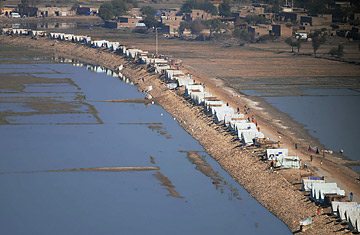
Tents set on higher ground for the flood-affected people in the area of Pakistan's Manchar Lake on Dec. 3, 2010
Dozens of people with outstretched arms welcome the chopper as its rotors kick up swirls of gritty dust from the cracked, mud-caked earth of Haji Jan Mohammad — a poor agricultural village transformed into a desolate island by waist-deep floodwaters that stretch to the horizon in every direction. More than four months after the worst flooding in Pakistan's history, vast stretches of land are still underwater in the province of Sindh, isolating many communities. The U.N. chopper ferrying wheat flour is the first help the marooned residents have seen, they say. "I could cry today. You people have come from God," says Mohammad Ismail, a short, stocky man whose mud-brick home once stood not far from the helicopter's landing site. There is no trace of it now.
The world's attention has long since moved on from the Pakistani flood story, but there are still more than 1 million people who remain displaced in Sindh alone, said U.N. humanitarian affairs chief Valerie Amos on Dec. 3 after touring the flood zone. Jackie Dent, a World Food Programme spokesperson, said that although isolated outlying villages are becoming "few and far between as waters recede and access improves," more are still being found. Last week at Jamshoro, near Lake Manchar, not too far from Haji Jan Mohammad, "WFP in cooperation with a local NGO and the Pakistani military located 11 cut-off villages with an estimated 1,700 families — around 11,900 people," Dent said.
At the height of the monsoon flooding, the wild waters could not be contained in the engorged lower Indus River that runs the length of Sindh before it empties into the Arabian Sea. An alternative water channel formed, mirroring the Indus but to the west. It was almost 100 km wide in some parts and 30 km across at its narrowest, according to retired Lieut. General Nadeem Ahmed, chairman of Pakistan's National Disaster Management Authority (NDMA). "The problem was that the level of water in the river was higher than in this alternative water channel so it could not drain into it and became stagnated in these six or seven districts," he says from his office in Islamabad. That situation has now been reversed and the waters are receding, he adds, pulling out several satellite maps of the area. On Nov. 25, the stagnant pool covered 618,511 acres (250,302 hectares) of villages and their surrounding agricultural land, the imagery shows. Just five days later, it had shrunk to 524,673 acres (212,328 hectares).
The really difficult work of rebuilding and recovery will begin after the areas have been drained. The World Bank and Asian Development Bank estimate nationwide flood damage at $9.7 billion, and there is a massive aid shortfall. Foreign donors have pledged just under half of the $2 billion the U.N. has asked for. Funding, as well as the relief and rebuilding efforts, have been marred from the start of this crisis in July by infighting between federal and provincial authorities.
Nadeem says it is within the NDMA's legal purview to undertake reconstruction and rehabilitation projects but that "for reasons best known to [the government of Pakistan]," the task has been assigned to provincial bodies. The general, a genial go-getter held in high regard by the many senior international relief workers who have worked with him since the flooding, is concerned that infrastructure will merely be restored rather than built to better standards. "That doesn't make sense," he says, but "somehow that point was not taken."
The government plans to give millions of the worst-affected people a one-time payment of about $1,000 toward rebuilding their homes. But unlike after the 2005 Kashmir earthquake, the funds will not be paid out in installments, removing a key oversight and control mechanism. Not one to be sidelined, Nadeem and his staff, along with U.N. Habitat, have come up with a "design menu" for flood-resistant, seismic-resistant homes built from a variety of materials, complete with costings and step-by-step instructions that they plan to distribute to millions affected by the flooding. But funding remains a problem. "The funding that has come for shelter, it's just about 18% [of what's needed], and agriculture is about 52%," he says. He concedes that it's hard to persuade donors to chip in when some $60 million of private donations in the "Prime Minister's fund" remains untouched because of political squabbling.
While Pakistan's power brokers bicker, its people continue to suffer. In Haji Jan Mohammad, the scale of destruction is awesome. The detritus of the villagers' lives is stuck in the dried mud: a toddler's pink plastic slipper, a navy blue sleeve, a broken teacup, a smashed cream plastic chair. The entire village of more than 60 families now lives on a small elevated mound, divided into male and female halves. Their fields have been turned into lakes, and two hired boats are their only lifelines to the nearest village, a 30-minute ride away. Many of the people said they wanted concrete homes instead of their traditional mud brick, given that only a handful survived unscathed. "We just feel forgotten," says Mohammad Ismail. "Nobody comes here. Can you help us?"
